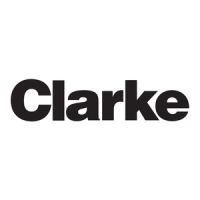Page 29 of 49
controls and prevents scale. These inhibitors are
available in various forms, such as liquid packages or
integral parts of anti-freeze.
It is imperative that supplemental inhibitors be added
to all Clarke engine systems. A pre-charge dosage
must be used at the initial fill and the maintenance
dosage used at each service interval. Serious damage
will occur unless inhibitors are used. Some of the
more common corrosion inhibitors are borates,
nitrates and silicates.
Inhibitors become depleted through normal
operation; additional inhibitors must be added to the
coolant as required to maintain original strength
levels. Refer Figure #24 for proper concentrations of
inhibitors.
Figure #24
Do not use soluble oils or chromate inhibitors in
Clarke engines. Detrimental effects will occur.
To properly check inhibitor concentrations it may be
necessary to contact your local Service/Dealer for
assistance. Refer to Parts Information Section to
obtain the part number for the factory Coolant
Analysis Kit. This kit can be purchased for a
nominal fee for analyzing the conditions of the
engine’s coolant.
3.4.6 Procedure for Filling Engine
During filling of the cooling system, air pockets may
form. The system must be purged of air prior to
being put in service. This is best accomplished by
filling with a pre-mix solution.
Note: On DT2H engines, it is important to loosen the
bolts in the banjo connections at the top of each turbo
to provide a vent during the fill. Once the initial fill
is complete, the bolts should be tightened and then
follow the partial fill instructions below.
Figure #25A
Caution: Do not overfill cooling system. A
pressurized system needs space for heat
expansion without overflowing.
3.4.6.1 Partial Fill
Install the pressure cap, start and run engine for
approximately 5 minutes in order to purge the air
from the engine cavities.
When verifying that the coolant is at a safe operating
level, it is best to wait until the engine temperature
drops to approximately 120ºF (49ºC), or lower,
before removing the pressure cap.
Remove the pressure cap and refill to the proper fill
level. To continue the deaeration process start and
run engine until the temperature stabilizes at
approximately 160°-200° (71°-93° C) or run engine
for 25 minutes, whichever is longer. During this
warming process, you may see coolant coming from
the overflow tube attached at the pressure cap
location. Allow engine to cool, then remove the
pressure cap and refill to the proper fill level.
Caution: Do not remove pressure cap while coolant
is at normal operating temperatures. Possible
personal injury could result from the expulsion of hot
coolant.
3.4.7 Providing adequate Raw Water Supply to the
Engine Heat Exchanger
3.4.7.1 Raw Water Supply
Most Clarke diesel engine fire pump drivers are heat
exchanger cooled and some engines also have a
charge air cooler (CAC) that uses raw water to cool
the air before entering the intake manifold. If you

